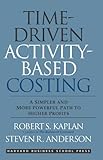Time-Driven Activity-Based Costing: A Simpler and More Powerful Path to Higher Profits
In the classroom, ABC looks like a great way to manage a company’s resources. But many executives who have tried to implement ABC on a large scale in their organizations have found the approach limiting and frustrating. Why? The employee surveys that companies used to estimate resources required for business activities proved too time-consuming, expensive, and irritating to employees.
This book shows you how to implement time-driven activity-based costing (TDABC), an easier and more powerful way to implement ABC. You can now estimate directly the resource demands imposed by each business transaction, product, or customer. The payoff? You spend less time and money obtaining and maintaining TDABC dataand more time addressing problems that TDABC reveals, such as inefficient processes, unprofitable products and customers, and excess capacity. The authors also show how to use TDABC to link strategic planning to operational budgeting, to enhance the due diligence process for merge
List Price: $ 45.00
Price: $ 23.00
Check This:
 Applied Data Analysis For Process Improvement: A Practical Guide To Six Sigma Black Belt Statistics
Applied Data Analysis For Process Improvement: A Practical Guide To Six Sigma Black Belt StatisticsWith the rise of Six Sigma, the use of statistics to analyze and improve processes has once again regained a prominent place in bu…
 Certified Six Sigma Black Belt Exam Flashcard Study System: CSSBB Test Practice Questions & Review for the Six Sigma Black Belt Certification Exam
Certified Six Sigma Black Belt Exam Flashcard Study System: CSSBB Test Practice Questions & Review for the Six Sigma Black Belt Certification ExamCertified Six Sigma Black Belt Exam Flashcard Study System uses repetitive methods of study to teach you how to break apart and qu…
 Certified Six Sigma Black Belt Exam Secrets Study Guide: CSSBB Test Review for the Six Sigma Black Belt Certification Exam
Certified Six Sigma Black Belt Exam Secrets Study Guide: CSSBB Test Review for the Six Sigma Black Belt Certification ExamCertified Six Sigma Black Belt Exam Secrets helps you ace the Six Sigma Black Belt Certification Exam, without weeks and months of…



New ABC Paradigm,
This is the book that I have been waiting for a long time. It addresses the major issues about the calculation of the resource drivers. Because it is based on linear regression model, it has a more scientific base than the previous ABC method. It can also be easily integrated into dynamic Activity-Based Costing Simulation model.
Was this review helpful to you?

|Comprehensive guide,
Activity-based costing can provide important insights; however, it also can be complex and difficult to implement and sustain. Time-driven activity-based costing more straightforwardly uses time as the primary metric for assessing costs, since almost all costs have a time dimension. Robert S. Kaplan and Steven R. Anderson provide a thorough, if highly technical, introduction to time-driven activity-based costing. Chapter by chapter, they show readers how to estimate process times, calculate capacity cost ratios, and plan and implement a TDABC system. Their detailed case studies illustrate the benefits of this clear, sophisticated tactic for budgeting, cost management, process improvement, benchmarking and acquisition evaluations. getAbstract thinks their book will be important to any executive, manager or academician who must understand operational costs.
Was this review helpful to you?

|A useful model for some businesses,
Activity-based costing was introduced in the 1980s to correct the inaccurate allocation of overhead from standard cost systems, but activity-based costing systems were expensive to build, complex to sustain, and difficult to modify, according to Robert Kaplan and Steven Anderson in this book. According to the authors, Time-Driven Activity-Based Costing is simpler, cheaper and more powerful.
The authors’ costing model assigns resource costs directly to resource objects. Firstly, a capacity cost rate is calculated for each department or process, being the total cost of the resources used by the department or process divided by the time available from the employees conducting the work. Secondly, an estimate is made of the demand for resource capacity that each cost object requires. This makes it very easy to see how much it costs to serve a particular customer, or how much excess capacity there is in a department.
The value to a business in implementing a system of the type advocated by the authors will depend on the extent to which the activities of the business consist of standard processes and the extent of benefits gained from knowing the cost of serving individual customers. The system might be better suited to a manufacturing firm, in which the time taken for each process can be estimated accurately, than to a law firm, where the mysterious activities engaged in by attorneys might defy rational measurement.
In my opinion the main value of the book is in the first few chapters where the principles of the system are explained. The last half of the book contains a number of case studies which are likely to be of interest only to those who have businesses similar to one or more of those described in the case studies.
Was this review helpful to you?

|